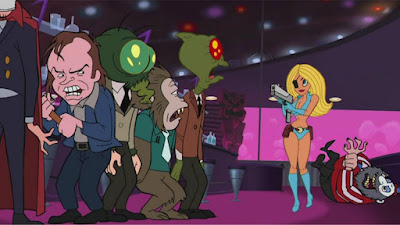Director: Peter Greenaway
Screenplay: Peter Greenaway
Cast: Colin Cantlie as the Narrator
An Abstract List Candidate
For me, one of the most rewarding films in the career of Peter Greenaway is Vertical Features Remake, an early short film which I will argue is one of the most perfectly executed in his career, hidden away at a period before making feature films which leaves it easy to malign next to many great titles more know. Presented as a public information documentary, in which a fictional group known as the Institute of Reclamation and Restoration attempt to recreate a lost film by the figure Tulse Luper, it also has importance to Greenaway's career. Tulse Luper, a character created as a journeyman and polymath, would have one of his most ambitious projects based around him, The Tulse Luper Suitcases trilogy (2003-4), one which despite being a trilogy including meta-narrative additions is among one of Greenaway's obscurest productions to see. Even among those you can find with greater ease, even little details like a specific water tower film archive used in image will be returned to for Drowning by Numbers (1988).
Set to library music synth, composed by Brian Eno, in its opening credits, Vertical Features Remake looks like an actual documentary from this era were it not for the production having to correct itself constantly. It is the driest of dry humours you will need to appreciate this, effectively a structuralist avant-garde film which however has a meta textual sense of the self-referential, but if you can get past the main content of the film, it is compelling. The main content is "Vertical Features", a project by Tulse Luper which, reinterpreted over multiple tries as new theories and archival documents are found, consists of 121 shots of vertical objects in English countryside towns being shown in order in a varying time per shot and sometimes set to music. This is the aspect which is still a dense and obtuse avant-garde film to experience. Viewed in the right light, as the later adaptations get said music and vary in shot length in more varying ways, it is actually peaceful to sit through the segments like one could an installation work, but it is the one thing you have to bear in mind as they are experienced as whole short films within one forty plus minute experimental production.
The humour is entirely how many jostling voices come into this project, predating Greenaway's The Falls (1980) and his experience at the Central Office of Information (COI) suggesting to him the farce of trying to create comprehensive archives. Told entirely with narrator Colin Cantlie, and still images representing everyone outside the Vertical Feature remakes, the arguments for and against the project, and having to remake this project over-and-over, does have an intellectual concept of how one struggles with attempting to recreate the past based on merely preserved notes and artefacts. It also gets to the point one figure will even question if Tulse Luper even exists, an excuse for the Institute of Reclamation and Restoration to get funding for this self indulgent technical editing exercise, which is where the dry farcical air comes in. Combined with Michael Nyman crafting most of the score, at the beginning of his work with the filmmaker, and this is as esoteric as you can get, crossing Greenaway parodying a documentary from the time but also sincerely, in many ways, creating an experimental structuralist film, its creation of a fake history as unconventional as you can get in terms of filmmaking.
And it predates The Falls' entire structure among other shorts he was make beforehand, his debut a three plus hour film parodying attempting to catalogue the world in a more elaborate and bizarre structure with this same template. The Falls is less avant-garde film reconstruction but more science fiction narrative of a world after an unknown incident turn people into bird people, with all the use of pre-existing photos and just more actual actors to push this further. It definitely shows, right from the get-go, Peter Greenaway would have easily continued into this experimental world but found himself moving towards dramatic narratives with the experimentation in their structures and themes, finding a way to go forwards. Here, subversively, even if still difficult he may have also figured out a way to make explicitly avant-garde material much easier to digest.
The beauty of the English countryside against very rigid experimental art is a fascinating juxtaposition to have, unlike other real experimental films which have pure coloured shapes and sound only, and the set-up as effectively a piss-take on the subject also makes the content have a greater depth. An argument is made by the end Tulse Luper's project, for a group known as Session Three to develop a "dynamic landscape", was actually a condemnation of his own group's plans by showing the potency of the landscape already, alongside hints at colleagues being likely to have destroyed or altered his work through their own goals. It is still, by parody and making an avant-garde film within a film, Peter Greenaway tackling subjects that will appear in his narrative works, where a lot of protagonists struggle in terms of making pure art or life goals fighting against individuals who wish for purely political, financial or emotional victories. It is, know to me for a long time, a secret masterpiece in Greenaway's career even for the simple fact that, effectively a short film, it is the right length, has no chaff even with four "remakes", and is artistically perfect as it is.
Abstract Spectrum: Avant-Garde/Meditative/Playful
Abstract Rating (High/Medium/Low/None): High


























